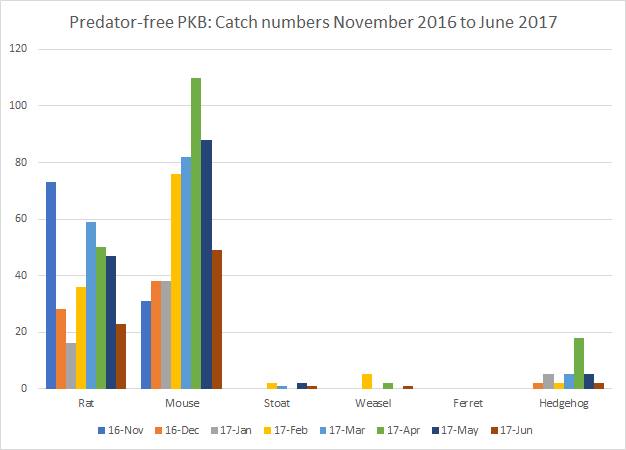 |
| Why we trap - to protect our native wildlife |
The Pukerua Bay community is nestled on the coast and is rich in natural features: a rocky coastline with a protected DOC scientific reserve, several forested gullies, remnant coastal forests, covenanted bush areas and small streams. Many properties have well established gardens which are already home to tui, kereru, grey warblers -riroriro, fantails - piwakawaka, silver eyes - tauhou, bellbird - korimako, and introduced birds.
 |
| Fledglings are particularly at risk from rats and other predators |
 |
| Pukerua Bay is home to at least 5 different species of native lizard, lizards are at risk for predation by rats, mice, mustelids and cats |
In this small community, of approximately 700 households, 130 now have trapping tunnels for rats and mice.
 |
| Trapping data from Predator Free Pukerua Bay includes trapping data from the DOC scientific reserve |
The monthly reports reflect seasonal trends - such as the mouse explosion in autumn as the mice come seeking warmth - but as the number of households with traps grows each month, it isn't possible to make a direct comparison, more traps will lead to more catches.
Getting past the 'ick' factor
 |
| Another rat caught, who would have thought the sight of a tail protruding from a trapping tunnel could be rewarding |
When I talk to people about joining up, the most common reason they give for not joining is what I call the 'ick' factor. "Oh I can't do that" they say. "What do you do with the dead animals?" "Do you have to touch them?" "Ugh!"
It's confession time, I am one of the most squeamish people on the planet! Among my family, my squeamishness is legend. Ten years ago, I could never have imagined I'd be emptying traps of little dead furry mammals. If anyone is proof that the 'ick' factor can be overcome it's me.
Squeamishness in humans is apparently an evolutionary response, it provokes us to avoid dangerous situations. I wonder, too, if we find it harder to kill mammals because of the soft furry cute factor? Well rats aren't that cute, but mice look so harmless don't they? And we've inherited European stories of cute hedgehogs and talking rats and mice.
 |
| Looking for the cute factor in New Zealand wildlife |
So how to get past squeamishness?
Believe me, you don't stop feeling squeamish, but you can get past it and do the job.
Reason and logic persuaded me to take action and not just leave it to others. Trapping rats and mice around dwellings is a 'no-brainer' - we don't need them chewing through wires, or getting into our roofs or cupboards. What about other species? I know that the battle between introduced predators and native wildlife isn't an equal one - that extinction waits around the corner for many of our native species. It's a fact that ferrets, weasels, stoats, possums, hedgehogs, rats, mice all cause damage to our native wildlife (so do pet cats and dogs but that's a topic for another day).
Humans introduced these predators to New Zealand, so logically we're the ones that will have to remove them now.
Here's some ideas for coping with that stomach-turning feeling:
- use a pair of gardening gloves for handling the traps
- choose a trap type that can be emptied without touching the dead body, dig a hole in the garden open the trap and drop the animal straight in
- check traps regularly, making this a routine helps normalise it, and regular checks mean you won't have to deal with a maggoty corpse
- remind yourself why you are doing this
- spend time appreciating the wildlife that you are protecting
- consider investing in a Good Nature trap that doesn't have to be emptied (you will still need to use mouse traps)
About five years ago, I joined a team checking DOC 200 traps around Pukerua Bay Scientific Reserve. This was the challenging because it's inevitable that some of the bodies have been in the traps for awhile. I tried to see the funny side of this and wrote about it in Throwing Hedgehogs to the Wind.
The best advice I can give to the squeamish is - if you care about New Zealand's wildlife - take action. Get those traps in place but don't leave it at that, find a feel-good contribution that suits you, such as weeding, planting, creating a garden that suits birds and lizards, counting birds, contributing sightings to iNaturalistNZ, monitoring lizards, beach clean-us, building nest boxes.
 |
| Add your sightings to iNaturalistNZ to track wildlife in your area |
Some Projects in or near Pukerua Bay
Planting and weeding projects - Pukerua Bay end of the escarpment https://kapitibush.org.nz
Lizard monitoring - Kapiti biodiversity and Friends of Mana Island
Garden Bird Survey - over for this year, but join in in 2108 http://www.landcareresearch.co.nz/science/plants-animals-fungi/animals/birds/garden-bird-surveys
Great Kereru Count - 22 Sept to 1 Oct 2017 https://www.greatkererucount.nz
Predator Free Pukerua Bay Facebook Group: https://www.facebook.com/groups/1541708729188335/
Creating a Lizard Friendly Garden http://www.forestandbird.org.nz/get-involved/backyard-projects-/backyard-biodiversity-/creating-lizard-friendly-garden
Planting for birds http://www.doc.govt.nz/get-involved/conservation-activities/attract-birds-to-your-garden/what-to-plant/
Articles:
Throwing Hedgehogs to the Wind: http://www.forestandbird.org.nz/www.forestandbird.org.nz/what-we-do/branches/kapiti-mana/Writing%20Comp%202013
Related websites/documents
About Pukerua Coast: http://www.gw.govt.nz/assets/council-publications/KeyNativeEcosystemPlanforRaroa-PukeruaCoast.pdf
Predator Free NZ: http://predatorfreenz.org